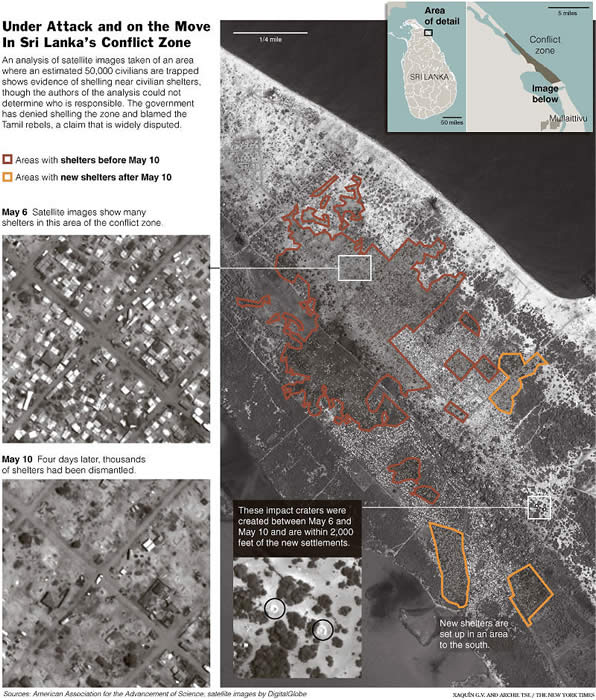Ilankai Tamil Sangam30th Year on the Web Association of Tamils of Sri Lanka in the USA |
|||
 Home Home Archives Archives |
Sri Lanka Attacks Said to Kill Dozens in Hospitalby Mark McDonald, The New York Times, May 144, 2009
At least 50 people were killed Wednesday when a primary school in Sri Lanka that had been converted into a field hospital was shelled for the second day, news agencies reported. The reports of the bombardment came as new satellite images were released showing the recent destruction of dozens of structures in the conflict zone where the Tamil Tiger rebels appear to be making a last stand against the government. Human Rights Watch said on Wednesday that the images backed up witness accounts indicating that the government was continuing to use heavy artillery in the densely populated zone. The government has denied shelling the area where an estimated 50,000 civilians remain trapped and said the rebels were behind the shelling, a claim widely disputed by human rights groups and foreign governments. At the United Nations, Security Council members issued a joint statement expressing concern over the mounting death toll. Previously, Russia, China, Libya and Vietnam had called the deepening crisis an internal matter, but diplomats said accounts of markedly rising casualties over the last several days helped overcome their resistance to take some action; late last month, the United Nations said an average of 70 civilians a day were being killed since late January. The joint statement was nonbinding but written to put pressure on the Sri Lankan government. President Obama also weighed in on Wednesday, urging both sides to stop harming civilians. In remarks to reporters, he said the rebels should lay down their arms and let civilians go, adding that “their forced recruitment of civilians and their use of civilians as human shields is deplorable.” He also called on the government to stop “indiscriminate shelling,” which he said had taken hundreds of lives, including at several hospitals. The hospital that was reported to be hit Tuesday and Wednesday is the last remaining medical center serving the civilians. Dr. Thurairaja Varatharajah, a government health official in the war zone, provided the toll by telephone to The Associated Press. The International Committee of the Red Cross has not been able to confirm the strikes on the hospital, and journalists have been barred from the conflict zone, so it is impossible to verify what is happening there. In the same compound on Tuesday, 49 people were said to have been killed by mortar rounds, news agencies reported. Separately, a local Red Cross worker and his mother were killed in shelling on Wednesday, a Red Cross spokesman said. The commercial satellite images released Wednesday were taken this month and were analyzed by the American Association for the Advancement of Science. They show dozens of structures that appear to have been destroyed between last Wednesday and Sunday, the preliminary analysis said, and multiple craters that appear to reflect the impact of heavy weaponry. The association did not place blame for the possible bombardment in its report. But Lars Bromley, a project director with the association, said that although artillery could be hidden, the preliminary analysis did not show big artillery pieces in the rebel-held zone. Sharon Otterman contributed reporting from New York, and Neil MacFarquhar from the United Nations. |
||
|
|||
